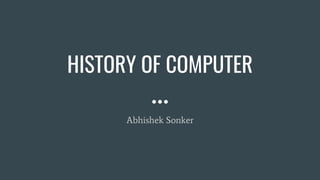History Of Computer.pptx
•Download as PPTX, PDF•
0 likes•2 views
The history of computers is a story of continuous innovation, from the earliest mechanical devices to the advanced technologies of today, shaping the way we live, work, and connect with the world.
Report
Share
Report
Share

Recommended
Recommended
More Related Content
Similar to History Of Computer.pptx
Similar to History Of Computer.pptx (20)
Information & Communication Technologies - Evolution

Information & Communication Technologies - Evolution
More from Abhishek Sonker
More from Abhishek Sonker (7)
Recently uploaded
Recently uploaded (20)
Custom Approval Process: A New Perspective, Pavel Hrbacek & Anindya Halder

Custom Approval Process: A New Perspective, Pavel Hrbacek & Anindya Halder
Designing Great Products: The Power of Design and Leadership by Chief Designe...

Designing Great Products: The Power of Design and Leadership by Chief Designe...
Essentials of Automations: Optimizing FME Workflows with Parameters

Essentials of Automations: Optimizing FME Workflows with Parameters
When stars align: studies in data quality, knowledge graphs, and machine lear...

When stars align: studies in data quality, knowledge graphs, and machine lear...
How world-class product teams are winning in the AI era by CEO and Founder, P...

How world-class product teams are winning in the AI era by CEO and Founder, P...
Connector Corner: Automate dynamic content and events by pushing a button

Connector Corner: Automate dynamic content and events by pushing a button
SOQL 201 for Admins & Developers: Slice & Dice Your Org’s Data With Aggregate...

SOQL 201 for Admins & Developers: Slice & Dice Your Org’s Data With Aggregate...
De-mystifying Zero to One: Design Informed Techniques for Greenfield Innovati...

De-mystifying Zero to One: Design Informed Techniques for Greenfield Innovati...
In-Depth Performance Testing Guide for IT Professionals

In-Depth Performance Testing Guide for IT Professionals
Knowledge engineering: from people to machines and back

Knowledge engineering: from people to machines and back
Kubernetes & AI - Beauty and the Beast !?! @KCD Istanbul 2024

Kubernetes & AI - Beauty and the Beast !?! @KCD Istanbul 2024
From Siloed Products to Connected Ecosystem: Building a Sustainable and Scala...

From Siloed Products to Connected Ecosystem: Building a Sustainable and Scala...
Salesforce Adoption – Metrics, Methods, and Motivation, Antone Kom

Salesforce Adoption – Metrics, Methods, and Motivation, Antone Kom
10 Differences between Sales Cloud and CPQ, Blanka Doktorová

10 Differences between Sales Cloud and CPQ, Blanka Doktorová
UiPath Test Automation using UiPath Test Suite series, part 3

UiPath Test Automation using UiPath Test Suite series, part 3
History Of Computer.pptx
- 1. HISTORY OF COMPUTER Abhishek Sonker
- 2. Early Calculators (Abacus to Pascaline): ★ The history of computing begins with tools like the abacus, which was used for basic arithmetic thousands of years ago. ★ In the 17th century, the Pascaline, an early mechanical calculator, was invented by Blaise Pascal. Analytical Engine and Charles Babbage: ★ In the 19th century, Charles Babbage designed the Analytical Engine, considered the first general-purpose mechanical computer. ★ Ada Lovelace, an early computer programmer, wrote algorithms for this machine.
- 3. Mechanical and Electromechanical Computers: ★ The late 19th and early 20th centuries saw the development of various mechanical and electromechanical computers. ★ Examples include the Tabulating Machine by Herman Hollerith, which was used for the U.S. Census, and the Z3, an early electromechanical computer developed by Konrad Zuse in Germany. Electronic Computers and ENIAC: ★ The true electronic computer era began with the construction of ENIAC (Electronic Numerical Integrator and Computer) in the 1940s. ★ ENIAC was the first general-purpose electronic digital computer and marked a significant breakthrough in computing technology.
- 4. Transistors and Integrated Circuits: ★ The invention of transistors in the 1950s revolutionized computing by making computers smaller, more reliable, and more powerful. ★ Integrated circuits (microchips) were developed in the 1960s, further miniaturizing and enhancing computer capabilities. The Personal Computer Revolution: ★ The 1970s and 1980s saw the emergence of personal computers (PCs) like the Apple II and IBM PC, making computing accessible to individuals.
- 5. Internet and World Wide Web: The 1990s brought the internet and the World Wide Web, transforming how people communicate, access information, and conduct business. Mobile and Smart Devices: The 21st century saw the rise of smartphones and tablets, becoming ubiquitous for communication and computing
- 6. Cloud Computing and AI: Cloud computing allows access to powerful remote servers, while artificial intelligence (AI) applications have made computers capable of complex tasks like speech recognition and image analysis. Quantum Computing (Emerging): Quantum computing, still in its early stages, holds the promise of solving problems that are currently beyond the capabilities of classical computers.
